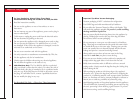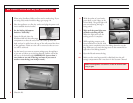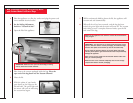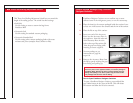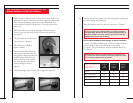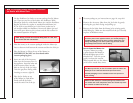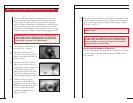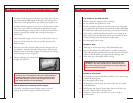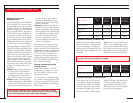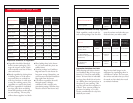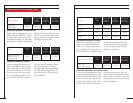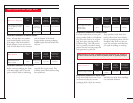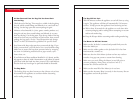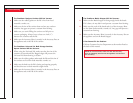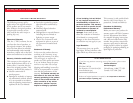
Food Preparation and Storage Guide
THE FOODSAVER USER MANUAL
23
THE FOODSAVER USER MANUAL
22
Where to Recommended Vacuum Normal Storage
MEATS
/FISH Store FoodSaver Packaged Life
(without
Container Storage Life
vacuum packaging)
Beef, Lamb, Pork
Freezer FoodSaver Bag 2 to 3 years 6 months
Ground meat Freezer FoodSaver Bag 1 year 4 months
Poultry Freezer FoodSaver Bag 2 to 3 years 6 months
Fish Freezer FoodSaver Bag 2 years 6 months
Where to Recommended Vacuum Normal Storage
C
HEESES Store FoodSaver Packaged Life
(without
Container Storage Life
vacuum packaging)
Cheddar, Swiss, Parmesan Refrigerator FoodSaver Bag 4 to 8 months 1 to 2 weeks
Preparation Guidelines for Meats/Fish:
Option 1: For best results pre-freeze
meats and fish for 1-2 hours before
vacuum packaging in a FoodSaver
Bag to ensure the retention of juices
and shape, and to help guarantee a
good seal.
Option 2: If it is not possible to pre-
freeze, place a folded paper towel
between the meat/fish and the end
of the bag. Leave the paper towel in
the bag when vacuum packaging to
absorb excess moisture and juices.
Preparation Guidelines for Hard Cheeses:
Keep cheese fresh even if you use
it everyday by vacuum packaging it
after each use. Make your original
FoodSaver Bag extra long. Simply
cut along the sealed edge, remove
the cheese and slice off the amount
needed, then place the cheese back
in the bag and repackage. Allow
approximately one inch of bag
material for each time the bag will
be opened and repackaged.
NOTE: Beef may appear darker after vacuum packaging due to the removal
of oxygen. This is not an indication of spoilage.
Guidelines for Vacuum
Packaging Food
Vacuum packaging is not a substitute
for canning nor can it reverse deteri-
orating quality; it can only slow down
changes in quality. It is impossible to
predict how long a specific food will
have top-quality flavor, appearance
and texture, because it depends on
the age and condition of the food
on the day it was vacuum packaged.
Any perishable foods that require
refrigeration still must be refriger
ated
or frozen after vacuum packaging.
Vacuum packaging extends the life of
foods by removing nearly all the air in
a sealed container, thereby reducing
oxidation which affects nutritional
value, flavor and overall quality.
However, most foods contain enough
water to support micro-organisms
which can grow with or without air.
While micro-organisms are present
everywhere, only certain ones cause
problems, and only under certain
conditions:
◗ Mold: Easy to identify because of
its characteristic fuzz. Molds are
virtually eliminated by vacuum
packaging because they cannot
grow in a low oxygen environment.
◗ Yeast: Results in fermentation,
which can frequently be identified by
smell or taste. Yeast requires water,
sugar and a moderate temperature
to grow, but can grow with or
without air. Refrigeration slows
the growth of yeast, and freezing
stops it completely.
◗ Bacteria: Frequently results in
discoloration, soft or slimy texture
and/or an unpleasant odor. Clostrid-
ium botulinum (the organism that
causes Botulism) can grow without
air under the right conditions,
cannot be detected by smell or
taste and, although extremely rare,
can be very dangerous.
Maintaining low temperatures is a
critical factor in preserving foods
safely. Growth of micro-organisms is
significantly reduced at temperatures
of 40°F (4°C) or below. Freezing at
0°F (-17°C) does not kill micro-
organisms, but stops them from
growing. For long-term storage, always
freeze “perishable” foods that have
been vacuum packaged.
Thawing and Heating Vacuum
Packaged Foods
Always thaw foods in either the
refrigerator or microwave – do not
leave “perishable” foods at room
temperature to thaw.
To microwave in a FoodSaver Bag,
cut a corner of the bag and place on
a microwave-safe dish. You can also
place the FoodSaver Bag in boiling
water to heat.
NOTE: Vacuum packaging is NOT a substitute for refrigeration or freezing.
Any “perishable” foods that require refrigeration prior to vacuum packaging
still must be refrigerated or frozen after vacuum packaging.



